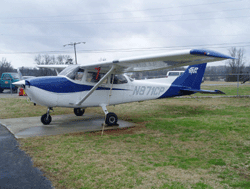In general, TAA’s are aircraft in which the pilot interfaces with one or more computers in order to:
- Aviate – Autopilot, moving map
- Navigate – GPS positional awareness, navigational databases of fixes, airports, approaches and terrain, fuel and time management
- Communicate. – Communications databases that allows selecting, preloading or automatically accessing and loading frequencies)
When most pilots hear the term Technically Advance Aircraft (TAA) they picture a Glass Cockpit in a Cirrus SR22. However, There are actually three categories of TAA:
- New Design, New Aircraft, fully integrated “glass panels”
- New Classic Aircraft (i.e. C172 or 182) with fully integrated “glass panels”
- Existing aircraft with traditional “six-pack instrumentation, retrofitted with modern autopilots, and combined GPS/Communications
Depending on how you view the issue of “Integration” Redstone Flying Activity has at least 8 aircraft that meet the minimum definition above:
- Three C172s
- Two Piper Arrows
- One Cessna 182 and One 182R which includes MFD and Stormscope
The capabilities of these systems have enhanced flight safety in many ways, reducing pilot workload, providing accurate navigation, and reducing loss of control accidents. These benefits have been demonstrated through accident data for several years. However there have also had some unexpected negative side effects on flight safety. Some of these issues are:
- Failures of pilots to completely understand in detail how the autopilot operates and how to recognize performance deviations and override them.
- Programming the navigator (GPS) consuming too large a part of the pilots mental bandwidth, causing him to lose situational awareness and get behind the aircraft
- Loss of “hand flying” skills. The extensive use of an autopilot for aircraft control causes a deterioration of pilot maneuver skills.
These negatives are not limited to Part 91 general aviation operations but have been evident in “Big Iron” Part 121 segment as well as Part 135 operators.
As a general rule, if you don’t know how to use the systems in your aircraft that automate functions, such as autopilots, Navigators (GPS), or programmable communications, you should not rely on them.
If You really want to increase your use of automation, first study the users manual. The document tab on the club home page website includes copies of the manuals for the autopilots in our aircraft. Then check the approved flight copy stored in the airplane for specific details on the actual installation. Learn how to use the autopilot in its most basic functions, Wing leveler and heading mode. These two modes provide the greatest safety advantage to you in the event of situations such as loss of control during marginal VFR, inadvertent VMC into IMC, or night flying. Be sure to understand possible failure modes and how to disconnect the system. Remember to preflight the unit as specified in the user manual. Fly using the basics for several flights until you are confident in your knowledge of its performance.
But remember, if you don’t understand what is happening disconnect it and resume hand flying!








